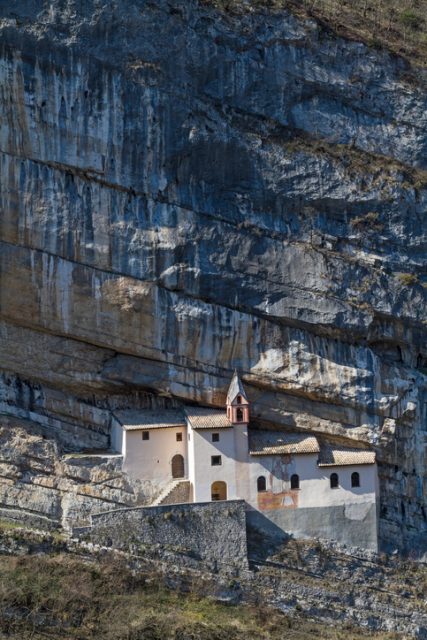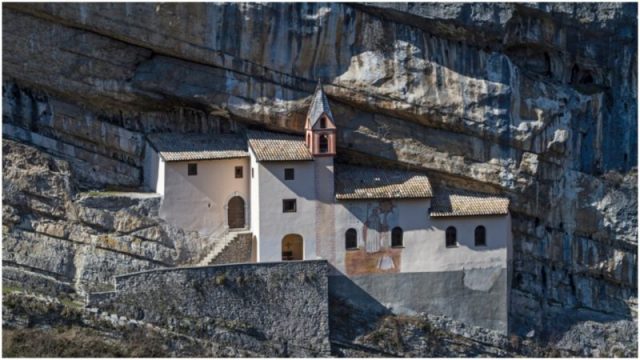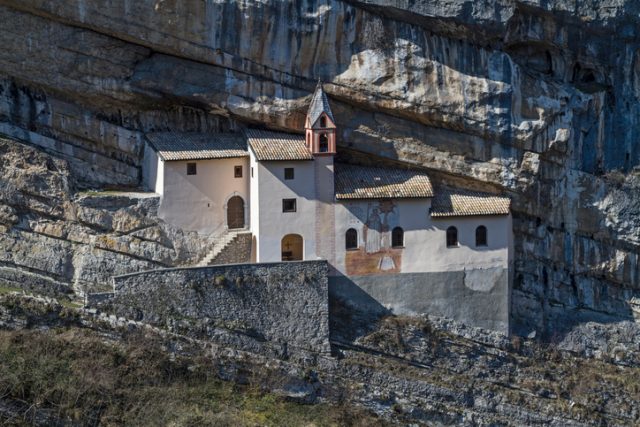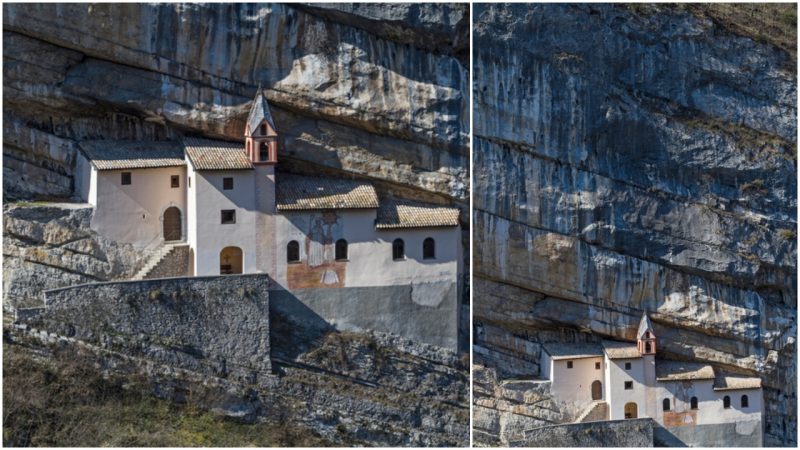Deep in the Leno Valley of Trento Province in the far north of Italy, next to lake Lago di San Colombano, solitude is taken to a whole other level and isolation literally to new heights.
While it is somewhat expected for a hermitage to be hard to reach, San Colombano Church is not off the beaten track as isolated places of worship usually are.
Partly a natural cave and partly excavated into the rock-face, it hangs 400 feet above the ground right in the middle of the valley’s vertical cliff face. It’s been there since the 8th century and climbing is the only way to get to it.
But it’s worth it. Of all the churches and monasteries in Italy, a country regarded as a cradle of Christianity and the home of thousands of places of worship, only this one has a legend of a pesky dragon to tell and is named after a heroic saint who defeated the beast. Well-preserved drawings inside depict this David-and-Goliath epic battle from back in the day.
A signpost for “Eremo di San Colombano” on the road from Rovereto to Vallarsa marks the path–iff a long pass through the narrow Leno gorge with gigantic cliffs looming on both sides could be even described as a path. Then follows a short bridge that allows for swift passage over the Leno di Vallarsa River, after which all that is left is a deadly cliff to scale, a couple of rocks, and 102 precarious steps to climb. “I want to be left alone” is what the post should read, for the place was definitely built to provide isolated spiritual contemplation.

It looks exactly as a holy place of refuge should. There is nothing to see, except for huge rocks and a flowing river below.
But it wasn’t all that quiet and serene 12 centuries ago. If the church over the years offered refuge and solitude to men who wished to be left alone, to be still and tranquil, legend has it that in these caves lurked a dragon.
According to local folklore, the beast would wreak havoc through the area and, 400 feet below, the beauty of the Leno river was not just a feast for the beast’s eyes. For as long as people can remember the area has been a holy land–and the river a place where every small child was baptized; they made easy prey for the dragon who would snatch them up and carry them off to its lair.
Many tried to slay the tormenting monster, but efforts all failed. Crushed to pieces, their bodies were just another full plate for the dragon to devour. Luckily, an Irish missionary from the Kingdom of Meath was in northern Italy to meet the royal family when he heard some rumors about this menace and rushed to see what’s what and, with God’s will, help the people who were suffering. No one knows how exactly, but St. Columban (the white dove) came out as the victor and a savior.

The dragon’s lair was than declared sacred and within a few years, the Leno Valley became a pilgrimage site. The saint passed away just a few years later, but it took almost a century and a half for the first daring pilgrim to set foot inside the sacred cave and become its hermit. And thus, somewhere around 750, what was a dragon’s nest grew into a shrine, the “Cave of the Hermits.”
The church looks like a framed picture hanging on a straight wall. Inside, on its walls, among the many drawings and frescoes, is one made by the first pilgrim, a drawing that shows the epic battle of the saint and the dragon. Another is supposedly drawn by the last hermit who, in search of solitude, stepped inside and found piece of mind in the small church hanging high above the Leno River.
The Hermitage in its current form was created around 1319. It was abandoned in 1782 when the Catholic Church banned the practice of solitary retreat, but the locals never left the place to rot and for over two centuries did everything they could to preserve it.

Each Christmas, the stairs are lit with torches as a homage to all the pilgrims and their last few steps of a long and hard walk taken in honor of a dragon-slaying saint.
However, to visitors, who by the way are more than welcome to come and see the place with their own eyes, the church is not the end of the road and the steps leading into it are not the last. Not the slightest.
They are only the beginning. Eremo di San Colombano is the starting point of a divine trekking route called “The Treasures of Trambileno.” The trek ends where the Leno River flows in Lago di San Colombano, and right after, as a reward, the trekkers can enjoy a chance to taste the local cuisine at Bosco Dei Pini Neri restaurant in Trambileno.
